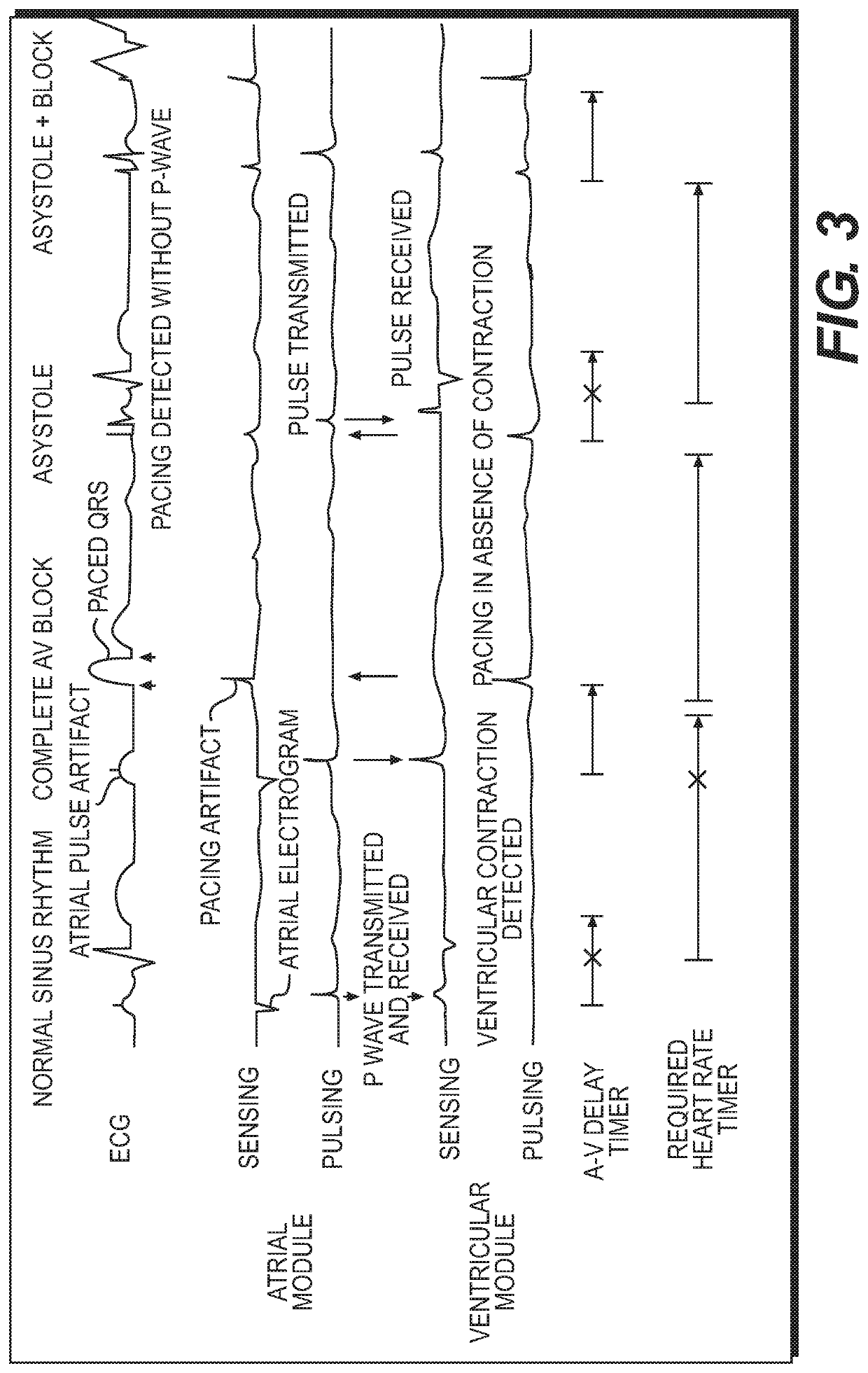[0009]The present invention addresses needs in the art by providing an epicardial pacing system that comprises or consists of one or more implanted modules, implantation means for percutaneous implantation and fixation of the implanted modules, lead designs that permit a pacemaker to lie flat against (i.e., substantially parallel to) the epicardial surface, thus reducing strain on the pacemaker and heart tissue and allowing for unimpeded cardiac motion. As depicted in the Figures, a pacemaker according to the invention has i) a length or height and ii) a width or diameter, such as in the shape of a cylinder. As such, when referring to the pacemaker lying flat against or parallel to the epicardial surface, it is meant that the surface defining the length or height lies substantially flat or parallel to the epicardial surface while the surface defining the diameter or width is substantially perpendicular to the epicardial surface. In preferred embodiments, the pacing system further comprises extracorporeal equipment for programming, monitoring, and recharging the implanted modules. Through practice of the invention, one may achieve cardiac pacing via one or more implanted devices, each of which has a form factor that permits minimally invasive, percutaneous implantation and fixation. One may also achieve cardiac pacing without placing devices in direct contact with blood flow in the endovascular or endocardial spaces. The present invention also provides a full range of programmable demand and rate responsive pacing algorithms comparable to conventional cardiac pacemakers. Through practice of the invention, one can augment failed or inadequate pacing through additional minimally invasive implants without the requirement of removing previously implanted devices. The invention additionally enables unlimited functional lifetime of implanted devices by supporting wireless inductive recharging of secondary cells powering those devices via an extracorporeally generated electromagnetic field, and enables unlimited functional lifetime of implanted devices by encasing the electronic circuitry and its power supply in a hermetically and preferably watertight sealed package. Yet further, the invention can be implemented to minimize the deleterious effects of continuous myocardial motion on the connection between electrodes and electronic circuitry. This is achieved by incorporating a flexible, durable hinge that connects the electrode to the electronic circuitry.
[0011]The present invention provides a novel micropacemaker design, and in particular a pacemaker lead design, to address the critical problem of complete heart block in patients of all sizes, including fetal patients, pediatric patients, and adult patients. Until recently, fetal heart block had no effective treatment except for early delivery because early attempts to implant an extra-uterine pacemaker with electrodes on the fetal heart invariably failed due to lead dislodgement from fetal movement. To address this problem, the present inventors designed a self-contained, single-chamber, rechargeable micropacemaker that can be completely implanted in the fetus without exteriorized leads, allowing for subsequent fetal movement without risk of electrode dislodgement. The present invention advances that concept to provide a percutaneous implantation scheme for micropacemakers and larger epicardial devices that provide demand pacing, variable rates, and a multi-chamber system via a modular configuration, as well as a battery having a life of potentially greater than six months between charges and being capable of being recharged wirelessly, which permits potentially decades of device life. The present invention further advances that concept by providing a lead design that reduces strain on the pacemaker electrode and on the myocardial tissue at the point of insertion of the pacemaker.
[0012]The device and system of the invention provides any one of, or any combination of two or more of, the following features: a percutaneous implantation technique to insert a single atrial or ventricular, or both an atrial and ventricular, pacemaker (e.g., micropacemaker, also referred to herein as a “modular device” or “implanted module”) device via a pericardial approach to the epicardium (this is similar to current implantation techniques used to perform epicardial ablations); wireless communication between one or multiple modular devices, in which each device can correctly identify the actions of the other device(s) and / or report relevant data to a detection device external to the patient, without the power consumption and interference risks inherent in RF communication; and the ability to incorporate rate responsive pacing to adjust pacing rates automatically based on the patient's dynamic physiologic need. Conventional rate responsive pacemakers use accelerometers or thoracic impedance sensing that are not directly suitable for the modular devices of the present invention, so the present invention uses a method based on sensing respiratory rate from impulses emitted by one module and sensed by the other(s), or an external sensing device; and long-term pacing required by adult and pediatric populations is accommodated by incorporating custom versions of existing ceramic packaging and battery technologies.
 Login to View More
Login to View More  Login to View More
Login to View More 


